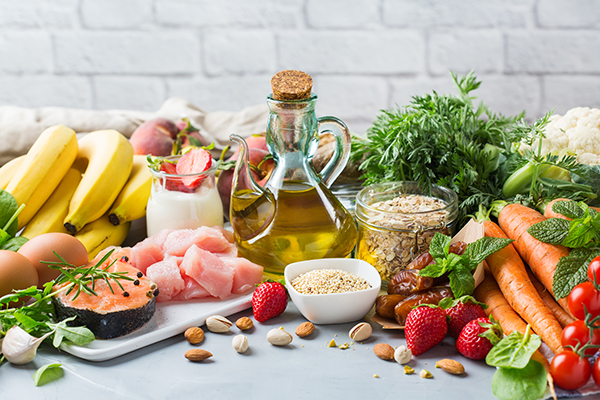The sweet saga of fruitcake: A nutritional powerhouse with a long shelf life
12/21/2024 / By Zoey Sky

- Fruitcake dates back to ancient Rome, where it was made from barley, honey, wine and dried fruit as an energy source for soldiers.
- In America, European colonists popularized fruitcake, using candied fruit to extend the shelf life of summer harvests, making it a holiday staple.
- Fruitcake’s high sugar content, low moisture and occasional soaking in spirits like brandy or bourbon create an environment inhospitable to bacteria and mold, allowing it to last for decades.
- Fruitcake contains antioxidants, nutrients and fiber that can support your overall well-being.
- While fruitcake has health benefits, its high sugar content can still cause blood sugar spikes if consumed in excess. Pairing it with water or tea can help slow digestion and prevent sugar crashes.
Nothing says Christmas like a decadent fruitcake — or, at the very least, a silly fruitcake joke. For decades, this dense, fruit-and-nut-laden dessert has been the butt of holiday humor, with jokes about its longevity and questionable taste circulating as freely as the cake itself.
But beneath the punchlines lies a rich history, a fascinating nutritional profile and a surprising array of health benefits that make fruitcake worth a second look this holiday season.
A history as rich as its ingredients
Fruitcake’s origins date back to ancient times, making it one of the oldest desserts in human history. The Romans are credited with creating the first version, a simple yet practical energy bar made from barley, honey, wine and dried fruit.
This early fruitcake was designed to fuel soldiers on the battlefield, proving that even in its infancy, fruitcake was a symbol of endurance and sustenance.
By the early Middle Ages, fruitcake had evolved into a more refined treat, with European bakers incorporating sweet spices like cinnamon, cloves and nutmeg. These aromatic ingredients were not only a sign of culinary sophistication but also a way to preserve and enhance the flavors of the dried fruits and nuts that were becoming increasingly popular in baked goods.
Over time, fruitcake consumption spread across Europe, with the cake taking on regional variations that reflected local ingredients and traditions.
In America, fruitcake found its footing with the arrival of European colonists. The influx of cheap sugar from the Caribbean made it possible to preserve fruit year-round, and candying fruit — a process that involves boiling it in sugar syrup and coating it in granulated sugar — became a popular method for extending the shelf life of summer harvests. This allowed colonists to enjoy the fruits of their labor well into the winter months, making fruitcakes a staple of holiday celebrations.
One of the most enduring myths about fruitcake is its seemingly infinite shelf life. Stories abound of fruitcakes that have survived for decades, even centuries, thanks to their high sugar content, low moisture and the occasional soak in high-proof spirits like brandy or bourbon. These factors create an environment inhospitable to bacteria and mold, allowing the cake to remain edible for years — or even decades — if stored properly.
Fruitcake’s legendary longevity made it a natural choice for mail-order businesses in the early 20th century.
With the advent of Rural Free Delivery in 1896 and the Parcel Post service in 1913, fruitcake companies like Claxton’s of Georgia and Collin Street of Texas became household names. Their fruitcakes, packed in sturdy tins and shipped across the country, became a beloved holiday tradition for many American families.
A nutritional powerhouse for the holidays
Despite its reputation as a dense, sugary indulgence, fruitcake offers a surprising array of nutritional benefits. (Related: Christmas pudding: A delectable, healthy treat worth serving this holiday season.)
At its core, fruitcake is a blend of dried fruits, nuts and whole grains, all of which are rich in essential nutrients. Here’s a closer look at what makes this holiday treat a potential health ally:
Antioxidants: Chemical protection for your cells
Dried fruits and nuts are rich in antioxidants, which help protect cells from damage caused by free radicals. This can reduce oxidative stress and lower the risk of chronic diseases like heart disease and cancer.
Dried fruit: A sweet source of nutrients
Dried fruits like apricots, cranberries and raisins are packed with natural sugars, fiber, potassium and iron. While the body processes these sugars similarly to refined sugars, the dried fruit also delivers a host of additional nutrients. Dietary fiber, in particular, helps promote satiety, making fruitcake a less likely culprit for overeating during the holiday season.
Nuts: A rich source of heart-healthy fats
Nuts like almonds, pecans and walnuts are a cornerstone of many fruitcakes. These ingredients are rich in monounsaturated and polyunsaturated fats, which are known to support optimal cardiovascular health. Nuts also provide a dose of protein, which can help keep you feeling full and satisfied.
Whole grains: A healthier choice
When made with whole wheat flour, fruitcake offers plenty of dietary fiber, which supports digestive health and helps regulate blood sugar levels. This makes fruitcake a healthier choice than many other holiday desserts, which are often loaded with refined carbohydrates.
While fruitcake does offer some health benefits, it is still an overindulgent dessert. Fruitcake’s high sugar content, even if it is natural, can contribute to blood sugar spikes if consumed in excess. Pairing a slice of fruitcake with a glass of water or a cup of tea can help slow digestion and reduce the risk of a sugar crash.
Healthy Christmas fruitcake recipe
This Healthy Christmas fruitcake recipe involves some soaking of the fruit used, but this step only takes 15 minutes. When you’re done, just mix all the ingredients, place it in the oven and glaze or ice it if you want to.
Ingredients:
- 500 grams mixed dried fruits
- 75 grams walnuts (3/4 cup)
- 5 Eggs
- 50 grams butter or coconut oil, melted (1/4 cup)
- 1 orange
- 125 grams almond flour/meal (1 1/4 cups)
- 67 grams coconut flour (1/2 cup)
- 1 tablespoon vanilla extract
- 3 teaspoons mixed spice (If you can’t find mixed spice, substitute three teaspoons of mixed spice as follows: 1 teaspoon cinnamon, 1 teaspoon allspice, 1/2 teaspoon nutmeg and 1/2 teaspoon ginger.)
- 1 teaspoon ground cinnamon
- 1/2 teaspoon baking soda
- 1/2 teaspoon Salt
- 60 mL amaretto or other liqueur of choice (optional) – if you don’t use this I recommend adding an extra 60mL of orange juice instead
Glaze (optional):
- 2 tablespoons honey or other liquid sweetener
- 2 tablespoons amaretto or other liqueur of choice
Instructions:
- Soak the fruit. Fill a kettle and let the water boil while you organize all the dried fruit into a large bowl. If you’re using larger fruits like apricots or dates, roughly chop them up first. Pour the hot water over the fruit and set it aside for 10 to 15 minutes to soften. Once done, drain and let the fruits cool to room temperature.
- Preheat the oven to 302 F (150 C). Line a 20-cm cake pan (preferably springform) with baking paper along the base and sides.
- Combine the almond flour, baking soda, cinnamon, coconut flour, salt and mixed spice in a large mixing bowl.
- In a separate bowl, whisk together the eggs, melted butter (or coconut oil), amaretto (or extra orange juice if you aren’t using liqueur) and vanilla. Squeeze in the juice of the orange. It’s fine if some orange pulp goes in.
- Create a well in the center of the dry ingredients and gradually stir as you add more of the mixture. Coconut flour is very absorbent so add it gradually. You should end up with a very thick batter, almost like a wet crumbly dough.
- Get the drained fruit and add it to the cake batter. Use a spoon to fold in the fruit until it is combined evenly with the batter.
- Scoop the cake batter into the lined baking pan and press down with your fingers or the back of a spoon until there are no gaps and the top is smooth.
- Bake the cake for between 60 to 70 minutes, or until the top is well browned and the center feels firm to the touch.
- If you’re going to glaze the cake, do so immediately while the cake is hot. Use a pastry brush to brush on the glaze. Alternatively, you can poke a few holes in the cake and then drizzle the glaze over to soak the cake.
- Set the cake aside and let it cool in the pan for 30 minutes then place on a wire rack to cool to room temperature. Keep the fruitcake in the fridge for about one week or freeze for a longer life.
Despite its detractors, fruitcake remains a robust part of American holiday traditions. According to the Serious Eats website, over two million fruitcakes are sold each year, proving that this dessert’s staying power is as strong as ever.
While it may never win over everyone, fruitcake’s rich history, unique texture and health benefits make it a worthy addition to your Christmas table. With its blend of delicious dried fruits, nuts and whole grains, fruitcake is a holiday treat that’s as nourishing as it is indulgent.
Visit Fruits.news to learn more about the health benefits of fresh and dried fruits.
Watch this clip about the health benefits of Organic Almonds, Cashews and Macadamia nuts.
This video is from the Health Ranger Store channel on Brighteon.com.
More related stories:
A toast to tradition: A nutritional and historical look at EGGNOG.
Enjoy a delicious cup of HOT COCOA, an energizing superfood bursting with antioxidants.
Pumpkin spice latte: Savor the perfect beverage for late autumn.
Here’s why marshmallow plants are one of Mother Nature’s nutritional treasures.
Sources include:
Submit a correction >>
Tagged Under:
Christmas, Christmas dishes, fruit bread, Fruitcake, holiday dishes, Holidays, how-to, natural health, natural ingredients, nutrients, nutrition, recipes, tips
This article may contain statements that reflect the opinion of the author
RECENT NEWS & ARTICLES
COPYRIGHT © 2017 NATURAL HEALTH NEWS




















